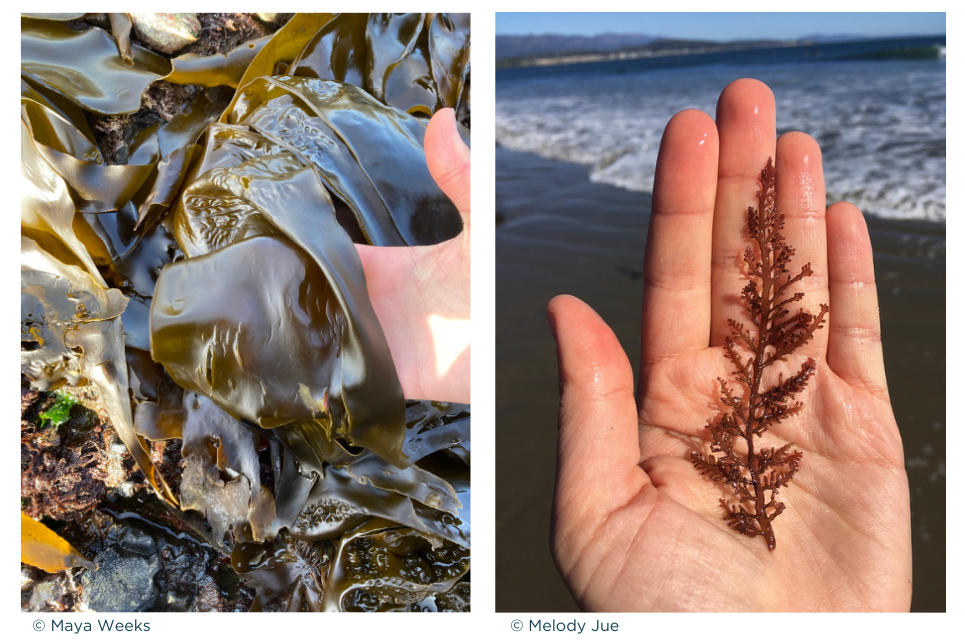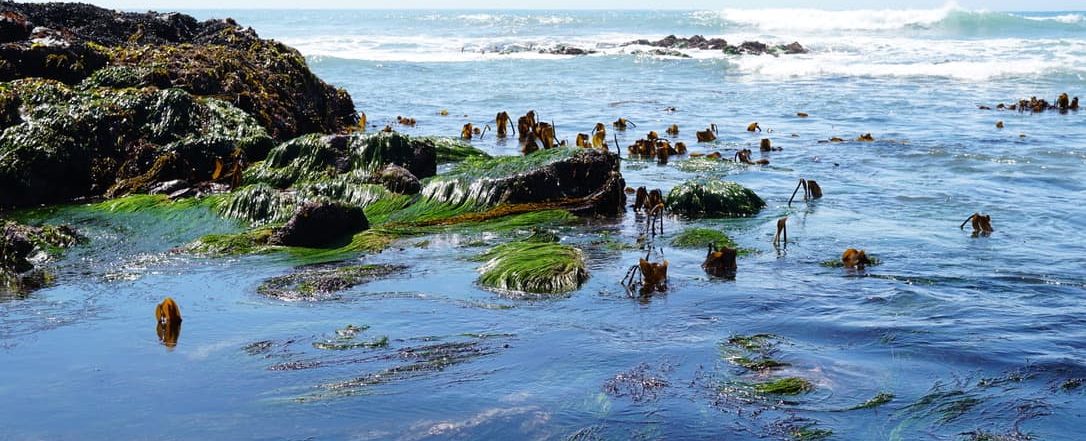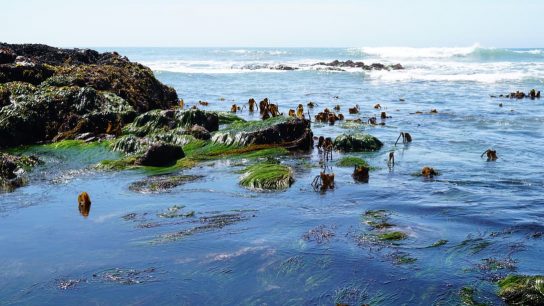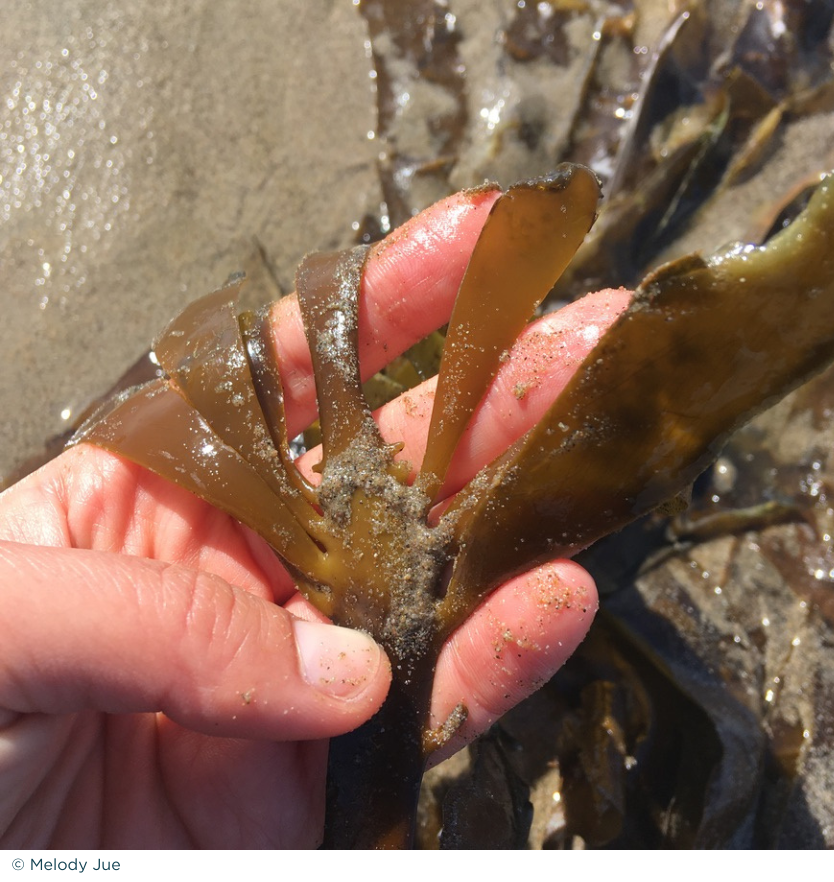Holding Sway: Seaweeds and the Politics of Form
by
“The contributors to this collection have also been swayed by the seaweeds themselves through modes of writing that reflect drifts in attention at field sites, or finding solidarity with seaweeds against extractive or colonial regimes.”
“Holding Sway: Seaweeds and the Politics of Form” is a series of photo essays that channels a visual curiosity about seaweeds with considerations of militarization, gender, Indigenous sovereignty, extractive regimes, and climate change. We invited participants to create or curate images that literally and figuratively “hold sway” in two senses: capturing the attention of an audience, or conveying a relationship of being in touch with seaweeds by holding their swaying botanical forms. The contributors to this collection have also been swayed by the seaweeds themselves through modes of writing that reflect drifts in attention at field sites, or finding solidarity with seaweeds against extractive or colonial regimes. In other moments, the photo essays exhibit a desire to sway you, the reader, to become curious and haptically dwell with the unctuous forms of seaweeds as they open toward more kelp-like ways of being in touch with coastal environments.
Throughout the photo essays that follow, seaweeds become a means of attuning to the specificities of place. Across a global range of geographies (or better, hydrographies), our contributors tend to seaweeds in the Eyak ancestral homeland in Prince William Sound, the Hawaiian island of Maui, the Sargasso Sea, the Scottish Hebrides, Japan, the United Kingdom, and Sweden. Each contributor articulates a specific relationship with the place from which they write. In turn, these relationships afford us—as readers, as editors—the ability to feel across states, fragments and fragmentation, refusals of colonial gazes, flatness and form, centuries of women’s labor, temporality, social reproduction, and tactility that encourages sensory awareness of our bodies as we read and gaze at the images. Yet seaweeds themselves are also of place. Seaweeds are morphologically plastic, growing into forms that best suit the conditions of the immediate environment. For example, calmer deep water, or shallower water beset by the ceaseless crashing of waves. Outside of the ocean, seaweeds are still shape-shifters: we find their extracts used in microbiology, in the historical manufacturing of gunpowder, in the stabilization of beer foam, in beauty products, and many other uses. The seven photo essays in this collection explore seaweeds and form in an expansive sense to include physical forms, life forms, political forms, cultural forms, and artistic media.
As you look through each essay’s curation of images, you may notice the recurring presence of hands, the tactile quality of surfaces, and other moments of contact. Contact printing features strongly in two essays: Sam Nightingale’s practice in “Para-photo-mancy” produced images of seaweed via direct contact with chemically-sensitive paper, while Gwen Arkin’s homage to the Hawaiian Kumulipo features anthotypes that pair seaweeds and terrestrial plants. Other photo essays suggest curiosity and care for seaweeds through the framing presence of hands, as in Jen Rose Smith’s and Jim Smith’s sibling/collaborative essay on growing baby kelp in their homewaters near dAXunhyuu territory. Their vibrant use of color in their photographic images enfolds kelp with bright water bottles and work boots and human hands—a working solidarity. In other photo essays, human hands are a measure of scale, or a means of unfurling the seaweed for the camera’s gaze, or more open-endedly expressive. Just as the hands are but a metonymic expression of human presence, the photo essays also feature parts and fragments of seaweeds in a metonymic relationship to fuller bodies.
The contributors to this collection upset the colonial gaze of taxonomy through visual, somatic, and historical strategies. They make sense of these seaweeds not in a Linnean sense of establishing order and thus dominance but through deep and curious investigation. Jen Rose Smith and Jim Smith write about kelp babies and the pressure settler violence places on them. Reflecting on shared Indigeneity, they write: “kelp is a rising star, a golden child of climate change who is said to have the potential to fix the knottiest branches of climate change issues that it did not help create. This sounds like a lot of pressure to put on one organism. We know the feeling.” Joe Riley interrogates capitalist enclosure and expansion in the 20th century via seaweed economies that demanded uniformity. The production of agar, as articulated in his essay, has been a process of amalgamation that extracted seaweed bodies into a kind of homogenized, standardized commodity that “found its way from kitchens into laboratories as a product of imperial ambition” and “became an (underrecognized) proxy for conflict.” By digging into archives and piecing together an economic history, Riley brings this conflict to light, refusing the homogeneity imposed on agar, thinking of different possibilities with seaweed.
“Just as the hands are but a metonymic expression of human presence, the photo essays also feature parts and fragments of seaweeds in a metonymic relationship to fuller bodies.”
Another key theme is the connection between elementality and politics. Angela YT Chan’s essay, “States of Hydration,” plays with two senses of state—both the political sense of states, and a more elemental sense of states of matter. These two senses of state come together in her digital collages, which feature both the fragments of satellite maps and almost liquidy impressions of seaweed bodies that seem to bleed through, much like Sam Nightingale’s contact prints in “Para-photo-mancy.” Chan brings together the satellite aesthetic of geopolitical surveillance, tracking patches of sargassum that flow between nation states, alongside the way seaweeds can dry and rehydrate in (for example) a nourishing seaweed broth in Cantonese cuisine. Cecilia Åsberg’s documentation of the coastal “wrack zone” in Sweden pays close attention to histories of militarization near Gotland and the convergence of leftover munitions alongside seaweeds that have been washed ashore. Åsberg describes a picturesque coastal background where “bony white and gray rock meet brown algae and the hope of finding amber” against decades of industrial, often military, waste, ranging from World War leftovers of munitions and mustard gas to agricultural fertilizers.
Authors also mark interest in moving among forms wet and dry, flattened and three-dimensional. This correlates to the tactility across all the pieces in the volume, which reminds us that we are in fact alive, living and breathing on planet Earth. Bryony Gillard channels attention to wet/dry forms when she asks “what happens when something slippery, living and intangible is pressed, dried and flattened? […] how does this transformation from unctuous and elusive to brittle and flat relate to ideas around collecting, naming and care, active and historicized feminisms?” In stills from “Unctuous Between Fingers,” workshop participants gently handle seaweeds, getting to know them with their bodies from their fingertips to their eyes, instead of through the flattening and controlling grasp of imperial scientific practices. When we read “Unctuous Forms, Seaweed Kinships,” we wonder at how lovely it must be to be wrapped into her friendships, a social world cued to the pleasure of working with people and commissioning works, of trusting and confiding, of inviting, and of receiving invitation. Angela YT Chan discusses how dried seaweeds are used to “form a tonic of reconstituted medicinal ingredients in many food cultures to restore our bodies with nutrients,” activating nourishment both physical and cultural. One feels the openness that sway can create.
Other contributions channel a sense of the spiritual or mystical along with the physical. Sam Nightingale’s “Attuning to the Politics and Poetics of Seaweed in the Hebrides,” for instance, merges the alchemical, mystical, and physical through a combination of walking and phytogram practices. It includes photographs of a thatched roof, walks, and “Para-photo-mancy:” a form of chemically-sensitive, rather than light-sensitive, photography that happens through contact between sensitized paper and seaweed bodies, a moment where “seaweed writes itself onto a photographic surface.” We wonder at the striking similarities between the palettes of blue and brown that characterize both the photographic prints and the Hebrides landscape of sky and kelp-strewn shore, especially as Nightingale reflects on possible futures of industrial seaweed extraction. Gwen Arkin honors the interrelation of land and sea that is central to the Kumulipo, the Hawaiian creation chant. Her anthotype prints use photosensitive emulsion of limu (seaweed) in order to create a contact print of a native Hawaiian plant when exposed to light. The resulting images are diptychs that feature a pressing of the plant alongside its pastel ocean- and sun-printed image—fully elemental in their gathering of sunlight, sea, and the terrestrial, with artifacts and speckles that invite the reader to look closer.
Finally, we want to note how much motion preceded all of these still images. We think not only of the transportation and movement around shorelines, aquaculture farms, and field sites, but also of laboring bodies. In “The Political Lives of Kelp & dAXunhyuu,” we note the motion of seaweed in water and being hauled onto the boat, and the moment of stillness when the seaweed is held up in hand for the camera’s momentary snapshot. In “The Military Forms of Seaweeds,” we think of the labor of carrying heavy bags of seaweed and slowly processing agar, of Claude Adams being sent across the Pacific Ocean by boat. In “States of Hydration,” we imagine the movement of satellites around the earth as they monitor drifting flows of sargassum, against the scale of loved ones in the kitchen busily simmering a batch of seaweed soup. In “Attuning to the Politics and Poetics of Seaweed in the Hebrides,” “Coastline Exposure: Staying in the Wrack Zone,” “Plant Pairings within the Kumulipo,” and “Unctuous Voices, Seaweed Kinships,” we think of the meditative process of seaweed collecting along beaches, while reflecting on pasts and futures. We hope that through these photo essays you, too, will be temporarily held by the sway of seaweeds as you encounter them across varied forms and formations.
“Holding Sway: Seaweeds and the Politics of Form” photo essay series
“The Political Lives of Kelp & dAXunhyuu,” Jen Rose Smith and Jim Smith
“Plant Pairings within the Kumulipo,” Gwen Arkin
“States of Hydration,” Angela YT Chan
“The Military Forms of Seaweeds,” Joe Riley
“Unctuous Voices, Seaweed Kinships,” Bryony Gillard
“Coastline Exposure: Staying with the Wrack Zone,” Cecilia Åsberg
“Attuning to the Politics and Poetics of Seaweed in the Hebrides,” Sam Nightingale



